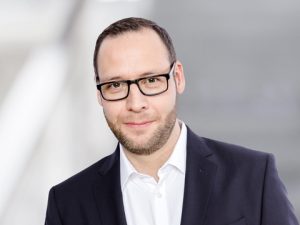PlazaMedia discusses new IP-based broadcast centre for Bundesliga season 2018/2019
PlazaMedia is building a new, IP-based broadcasting centre scheduled to start operations for the new Bundesliga season 2018/2019 in Ismaning near Munich, Germany. The company is investing in a freely scalable and futureproof infrastructure with a total data throughput of 6.4 terabits per second. We spoke to Jens Friedrichs, chairman at PlazaMedia, about how the company is utilising IP and other innovations within the broadcasting centre, and how the finished building will be used.

PlazaMedia chairman, Jens Friedrichs
What are the game changing technological innovations you are working with today, and why?
The launch of its new broadcasting centre will make PlazaMedia the first playout provider in Europe to have a fully IP-based solution, which is unique in this form. We are leaving behind the world of conventional broadcasting centre technology altogether, consciously opting against a hybrid solution and creating the most modern and future-proof system conceivable. This is a logical choice that provides us, and our customers especially, with the greatest possible flexibility and scalability.
Our broadcasting centre has up to 17 multi-purpose operating rooms which effortlessly bring whatever service is required directly to any workstation at the touch of a button; simply select a task profile. This lets us freely distribute tasks to different rooms and workstations, no longer assigning specific roles to each room. Our customers can book a service at any given time and we can provide it without complications or added effort.
IP is a much-discussed subject, but where do you see it having the biggest impact in sports broadcast? How is it set to disrupt the market?
The strengths of IP-based systems are scalability and flexibility; this applies to sports broadcasting just as well as to any other application. IP technology transcends any physically defined infrastructure. In the future we will rely on fully standardised and connected solutions, while the market used to be dominated by proprietary systems. As a result, we can take care of all steps, from broadcast management to graphics and audio editing from any workstation.
At the same time, we now have an IP-based backbone which not only serves as a platform for the broadcasting centre, but can also be used by other systems at any given time. Once an IP-based infrastructure like that is up and running, features and components can be added and extended as required. For instance, a new IP-based production management function can be directly and seamlessly integrated into the existing infrastructure.
That is one of the main reasons why we opted against a hybrid solution. Their scalability makes IP-based systems especially future-proof.
You are working on a new broadcasting centre for the 2018/2019 Bundesliga season. What are the challenges in creating this centre technologically and logistically? How will it be used when complete, and by whom?
The greatest challenge – and our greatest asset – was developing the solutions for our broadcasting centre with two vendors, Nevion and Lawo. This unique collaboration between two leading and competing enterprises and us as their customer let us explore new territory while developing our system. We no longer had to compromise and choose between options, but could use the best products of both providers and integrate them into one solution.
As a result, we have developed a best-of-class solution that is completely unique. In terms of logistics, orchestrating the suppliers and installing and launching the system were the greatest challenges. The 2018/2019 Bundesliga season gives us a fixed deadline. But our close relationship to the vendors has also paid off in this respect.
The broadcasting centre will serve a wide variety of purposes. We will use it as a network operations centre (NOC) to manage signal reception, distribution, and contribution in-house. Its second major purpose is running live and near-live signals. In addition, playout and content refinement such as graphics and highlight editing are integrated here. There are also plans for integrating post production services, a new streaming platform, and a new MAM system.
The broadcasting centre will be used by our existing customers, but thanks to the flexible and scalable nature of the system we will also have additional capacity. One of our main goals was to create the capacity to take on new customers and projects, which we now have.
In the future, how will we be able to manage a significantly higher volume of concurrent projects based on IP than previously possible, even at short notice, and with lower operating costs?
The key component for that is resource management. Thanks to the VSM controller, which manages and assigns individual functions, we have eliminated the extensive setup times formerly required. Our customers can get started on their projects immediately after producing them and use our multi-purpose workstations without the need to adapt each room to their specific requirements first. This not only increases the frequency of projects, but also reduces our workload as a service provider in the long run, allowing us to provide a whole new level of availability to our customers.
The great advantage of this technology is cost efficiency, because individual functions can be booked as needed. Our customers end up saving money, because they get exactly what they need and no additional resources are tied down.
